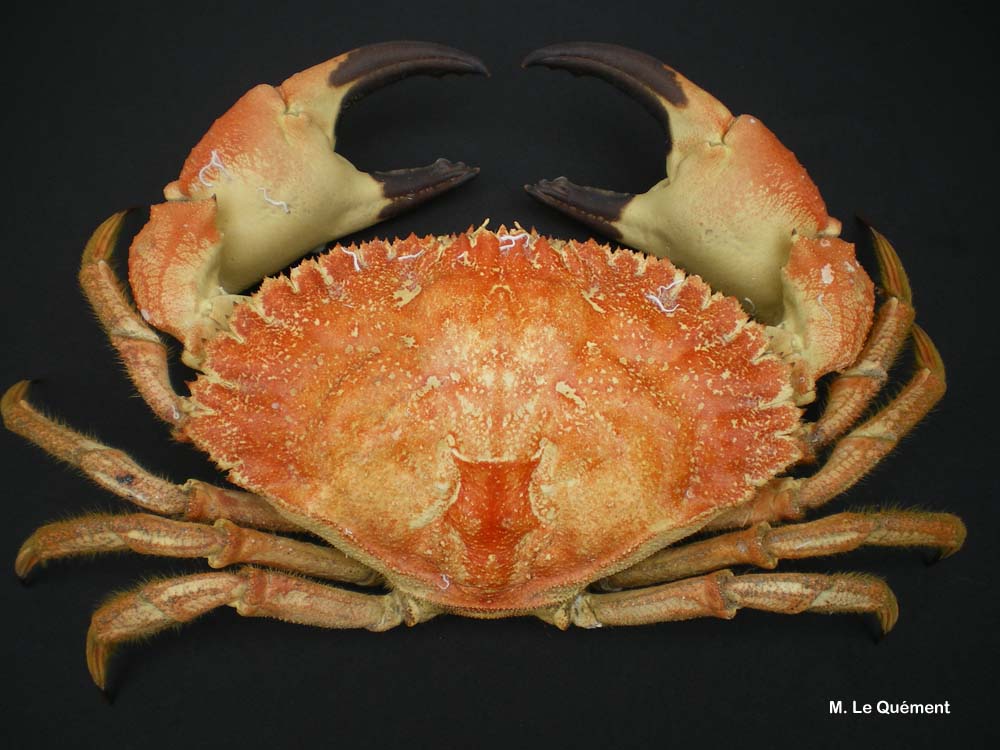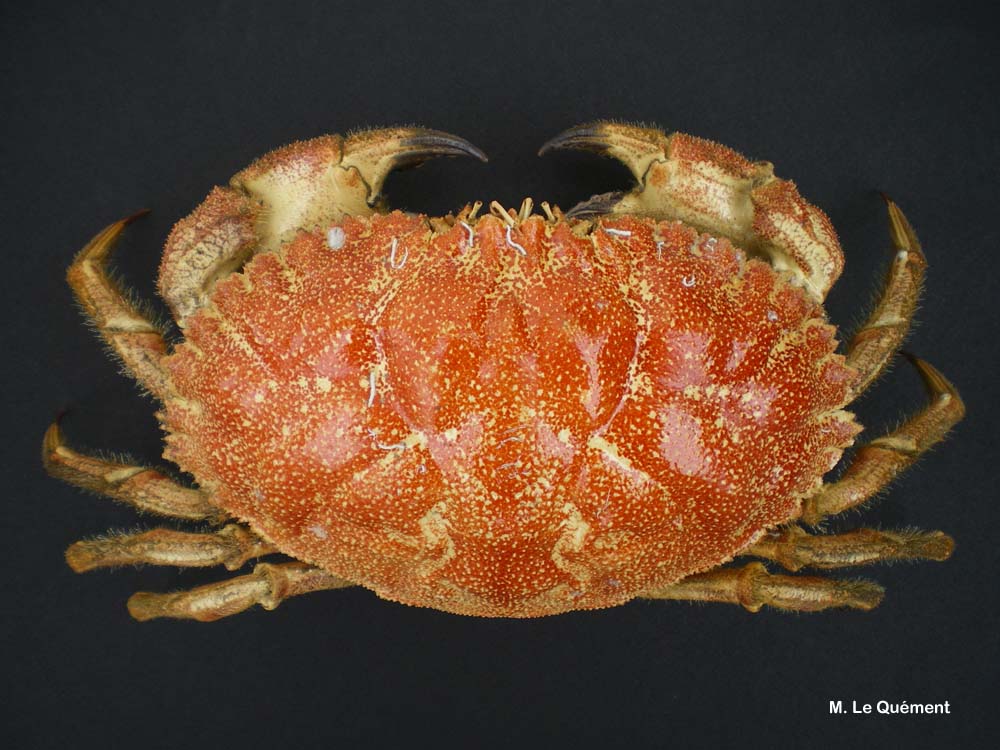
cd_nom

| Author : M. Le Quément |
 |
To get the picture, please visit:
Michel Le Quément, c/o M. Pierre NoëlSPN et Département Milieux et Peuplements AquatiquesMuséum national d'Histoire naturelle43 rue BuffonCP 48, F-75231 Paris cedex 05pierre.noel [at] mnhn.fr
Any reuse of one or more photographs on this site is subject to an authorization request from the author.
Link to the Code of Intellectual Property (Legifrance)

| Author : M. Le Quément |
 |
To get the picture, please visit:
Michel Le Quément, c/o M. Pierre NoëlSPN et Département Milieux et Peuplements AquatiquesMuséum national d'Histoire naturelle43 rue BuffonCP 48, F-75231 Paris cedex 05pierre.noel [at] mnhn.fr
Any reuse of one or more photographs on this site is subject to an authorization request from the author.
Link to the Code of Intellectual Property (Legifrance)
Morphologie : La carapace du tourteau rose est nettement plus large que longue, transversalement ovale et granuleuse sur la surface dorsale par ses nombreux petits tubercules proéminents, avec des sillons et régions bien marquées. Les lobes du bord antéro-latéral sont tridentés (trois ou plus rarement quatre dents). La région frontale avec une dent médiane triangulaire est plus avancée que les deux lobes latéraux. Les péréiopodes I disposent de tubercules et carènes épineux. Les doigts des péréiopodes II à V sont notablement plus longs que le propode. Cancer bellianus atteint une taille maximale de 136 x 221 mm et un poids de 1 ,9 kg ; mâles et femelles sont à peu près de la même taille. Ce tourteau est de couleur rougeâtre à brun pâle tacheté de rouge ; les doigts des chélipèdes sont noirs presque jusqu'à la base.
Biologie : Les femelles peuvent être ovigères toute l'année ; selon leur taille, elles pondent 300.000 à 1.400.000 œufs.
Ecologie & distribution : C. bellianus vit sur des fonds divers et notamment sur des fonds sableux entre (37) 100 m et 750 m de profondeur, avec une abondance (relative) maximale entre 200 m et 500 m. Il est présent de l'Atlantique nord-est du sud de l'Islande et des Shetland jusqu'aux îles Canaries et au sud du Sahara occidental. Il est absent du Sud de la Mer du Nord et de la Manche ainsi qu'en Méditerranée.
Interactions avec les activités humaines : Cette espèce est relativement rare ; quelques spécimens sont occasionellement pêchés.
Références : Quiles J. A., Rico V., Tuset V.M., Santana J.I., González J.A., 2001. Notes on the biology of Cancer bellianus (Brachyura, Cancridae) around the Canary Islands. Hydrobiologia, 449: 193-199.
Franck Coudray et Pierre Noël(UMS 2006 Patrimoine Naturel (AFB / CNRS / MNHN)),2012
Continental
Metropolitan France
Overseas
Marine
Metropolitan France
Overseas
The map presents a summary at the 10 x 10 km grid of the observation data for the species transmitted to the SINP. These data have been subjected to validation filters.
The map presents a reference distribution layer of the species at the scale of departments and marine sectors. The presence and absence data were established by expertise within a network of partners. This reference distribution is used in the validation process of the SINP data at the INPN level.
Corresponds to a report on the basis of at least one observation proved within a period of 10 years (20 years for little-known invertebrates) preceding the year and no presumption of extinction since obtaining the last data nor doubt on reproductive and implemented nature of this population. For migratory species, the presence indicated concerns areas of reproduction.
This status is based on one or more of the following criteria:
This point covers the absence, more difficult by nature to demonstrate than presence. This status is based on one or more of the following criteria:
This status must be assigned to a department in which the presence of the species is casual.
Particular case of absence due to a proven extinction less than a half century ago (older disappearances are treated as "no probable or definite").
In the state of knowledge, we can not comment on the presence or absence in the current department. This is the default status when not comprised in one of the previous categories or whenever there is doubt.
The map shows the global distribution of the species based on GBIF data (Global Biodiversity Information Facility).
